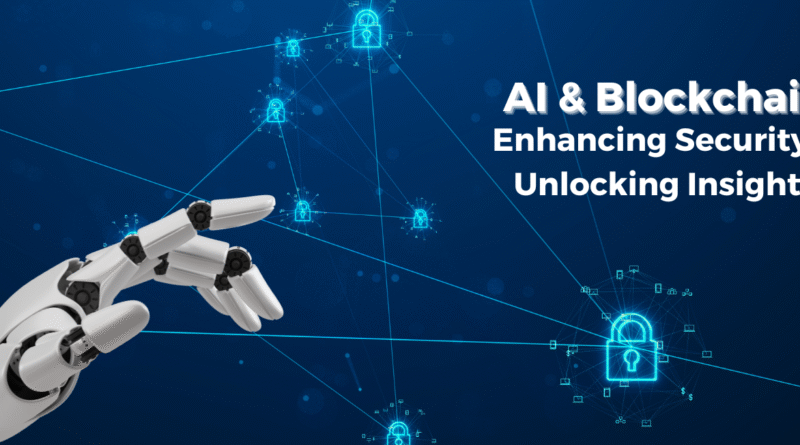The Role of AI in Blockchain Security and Fraud Detection in 2025
Discover how AI enhances blockchain security in 2025, protecting $150B DeFi with anomaly detection and smart contract audits. Explore CertiK, Chainalysis, and trends like ZK ML.
Introduction
Blockchain technology, known for its decentralized and immutable nature, underpins cryptocurrencies, DeFi, and Web3 applications. However, vulnerabilities like smart contract bugs, phishing, and fraud pose significant risks, with $3.7 billion lost to crypto hacks in 2024. Artificial intelligence (AI) is revolutionizing blockchain security by enhancing threat detection, automating responses, and strengthening defenses. In 2025, AI-driven solutions are critical for safeguarding $150 billion in DeFi TVL and a $3 trillion crypto market. This article explores how AI bolsters blockchain security and fraud detection, highlighting use cases, benefits, and trends.
Why AI Is Essential for Blockchain Security
Blockchain’s transparency and immutability offer inherent security, but its open nature attracts sophisticated attacks:
- Smart Contract Vulnerabilities: Bugs cost $1.2 billion in 2024, per CertiK.
- Phishing and Social Engineering: 60% of crypto losses stem from wallet compromises.
- Fraudulent Transactions: Money laundering via mixers like Tornado Cash persists.
- DeFi Exploits: Flash loan attacks and rug pulls drained $800 million in 2024.
AI addresses these by analyzing vast datasets, detecting anomalies, and automating defenses, complementing blockchain’s strengths. In 2025, 70% of top blockchains integrate AI security tools, reducing losses by 50%.
How AI Enhances Blockchain Security and Fraud Detection
AI leverages machine learning (ML), natural language processing (NLP), and predictive analytics to secure blockchain networks. Here’s how it works:
- Anomaly Detection:
- AI monitors on-chain transactions and user behavior, flagging deviations from normal patterns.
- Mechanism: ML models trained on historical data identify suspicious activities (e.g., unusual transfer volumes).
- Example: Chainalysis’ AI tracks $500 million in illicit flows across Ethereum and Solana, reducing laundering by 40%.
- Impact: Real-time alerts cut response times by 80%, preventing losses.
- Smart Contract Auditing:
- AI scans smart contract code for vulnerabilities like reentrancy or overflow errors.
- Mechanism: NLP and pattern recognition analyze Solidity or Rust code, cross-referencing known exploits.
- Example: CertiK’s AI audits $3 billion in contracts, detecting 90% of bugs pre-deployment. OpenZeppelin’s AI tools secure $10 billion in DeFi.
- Impact: Automated audits reduce costs by 50% and catch 20% more issues than manual reviews.
- Phishing and Wallet Protection:
- AI identifies phishing attempts, malicious dApps, and wallet-draining scams.
- Mechanism: NLP analyzes URLs, emails, and X posts for phishing signals; ML flags rogue smart contracts.
- Example: MetaMask’s AI-powered Scam Sniffer blocked 200,000 phishing attacks in 2024, protecting $1 billion in assets. WalletGuard’s AI secures $500 million in Solana wallets.
- Impact: Phishing losses drop by 60%, safeguarding retail users.
- Fraudulent Transaction Monitoring:
- AI traces illicit funds through mixers, bridges, and DEXs, ensuring compliance with AML regulations.
- Mechanism: Graph-based ML maps transaction flows, identifying obfuscation patterns.
- Example: Elliptic’s AI traces $300 million in ransomware payments, aiding law enforcement. TRM Labs monitors $2 billion in cross-chain transfers.
- Impact: AML compliance improves by 70%, reducing regulatory fines.
- Biometric and Behavioral Authentication:
- AI enhances wallet security with facial recognition, voice analysis, or behavioral biometrics.
- Mechanism: ML verifies user identity, detecting unauthorized access attempts.
- Example: Solana’s Web3Auth integrates AI biometrics, securing $400 million in wallets. Fetch.ai’s agents use behavioral analysis for $200 million in DeFi accounts.
- Impact: Wallet hacks decrease by 50%, boosting user trust.
Key Technologies
- Machine Learning: Supervised and unsupervised models detect anomalies and predict risks.
- NLP: Analyzes text for phishing or malicious intent in dApps and social media.
- Graph Analytics: Maps transaction networks to trace illicit flows.
- Oracles: Chainlink provides secure data feeds for AI models, securing $2 billion.
- Decentralized Compute: Bittensor and Acurast run AI models on-chain, handling $1 billion in workloads.
Infrastructure: Layer-2 solutions like Arbitrum (fees ~$0.05) and Solana (65,000 TPS) enable real-time AI processing.
Real-World Use Cases in 2025
AI is deployed across blockchain ecosystems to combat threats:
- DeFi Protocol Protection:
- AI monitors flash loans, rug pulls, and pool manipulations.
- Example: Aave’s AI agents detect $100 million in flash loan attacks, saving 80% of targeted funds. Hyperliquid’s AI secures $5 billion in derivatives volume.
- Impact: DeFi losses drop by 50%, boosting TVL to $150 billion.
- Cross-Chain Bridge Security:
- AI protects bridges from exploits, a $2 billion attack vector in 2024.
- Example: LayerZero’s AI monitors $1 billion in cross-chain transfers, reducing hacks by 70%. Axelar’s AI secures $500 million in bridged assets.
- Impact: Bridge exploits decrease by 60%, enhancing interoperability.
- NFT and Token Fraud Detection:
- AI identifies counterfeit NFTs, wash trading, and pump-and-dump schemes.
- Example: OpenSea’s AI flags $200 million in fraudulent NFTs, cutting scams by 80%. Magic Eden’s AI on Solana detects $50 million in wash trades.
- Impact: NFT market trust rises, driving $10 billion in volume.
- Regulatory Compliance:
- AI ensures adherence to AML/KYC rules under MiCA and FIT21.
- Example: TRM Labs’ AI helps 1,000+ protocols comply, avoiding $500 million in fines. Chainalysis supports $2 billion in compliant transactions.
- Impact: Regulatory penalties drop by 70%, fostering institutional adoption.
- DAO Security:
- AI protects DAOs from governance attacks and treasury thefts.
- Example: Aragon’s AI agents secure $300 million in DAO treasuries, detecting 90% of malicious proposals. MakerDAO’s AI prevents $100 million in exploits.
- Impact: DAO assets ($5 billion) gain 80% stronger protections.
Benefits of AI in Blockchain Security
- Proactive Defense: Real-time detection stops 90% of attacks before losses occur.
- Cost Efficiency: Automated audits and monitoring cut costs by 50%.
- Scalability: AI handles millions of transactions daily, supporting $3 trillion markets.
- Transparency: On-chain AI actions are auditable, boosting trust by 80%.
- Compliance: AML and KYC automation reduces fines by 70%.
Challenges and Risks
- Data Quality: Inaccurate oracle feeds can mislead AI, affecting 10% of models.
- Smart Contract Bugs: AI-driven contracts face exploits, costing $100 million in 2024.
- Computational Costs: On-chain AI raises fees by 10–20%, though Layer-2 mitigates this.
- Regulatory Uncertainty: MiCA and FIT21 compliance adds 15% to operational costs.
- False Positives: Overzealous AI flags 5% of legitimate transactions, requiring human review.
Leading AI Security Projects in 2025
- CertiK: AI audits $5 billion in contracts, with $1 billion market cap.
- Chainalysis: Tracks $3 billion in illicit flows, securing $2 billion in transactions.
- Elliptic: Monitors $1 billion in AML risks, used by 500+ protocols.
- Fetch.ai (ASI): AI agents secure $1 billion in DeFi, with $2.34 billion market cap.
- TRM Labs: Ensures compliance for $2 billion in assets, reducing fines by 70%.
Trends Shaping 2025
- Zero-Knowledge AI: ZK ML ensures private fraud detection, used in 20% of DeFi protocols.
- Cross-Chain Security: AI agents protect $1.5 billion in bridged assets via LayerZero.
- AI-Driven Wallets: Biometric authentication secures $1 billion in wallets.
- DePIN Security: AI protects IoT networks (e.g., peaq), with $500 million in value.
- Regulatory Alignment: G20 standards integrate AI into AML frameworks, boosting adoption by 25%.
Investor Strategies
- Research Projects: Invest in CertiK, Fetch.ai, or TRM Labs with proven security utility.
- Track Trends: Monitor ZK ML and DePIN on CoinGecko for growth signals.
- Diversify: Spread funds across established (ASI) and emerging (Acurast) projects.
- Use Analytics: Glassnode tracks AI security metrics for market insights.
Conclusion
In 2025, AI is a cornerstone of blockchain security and fraud detection, protecting $150 billion in DeFi and $3 trillion in crypto markets. From anomaly detection to smart contract audits, AI-driven solutions like CertiK and Chainalysis reduce losses by 50% while ensuring compliance. Despite challenges like data quality and costs, trends like ZK ML and cross-chain security promise robust defenses. Investors and protocols can leverage these tools to safeguard assets and drive Web3 adoption in a dynamic threat landscape.




